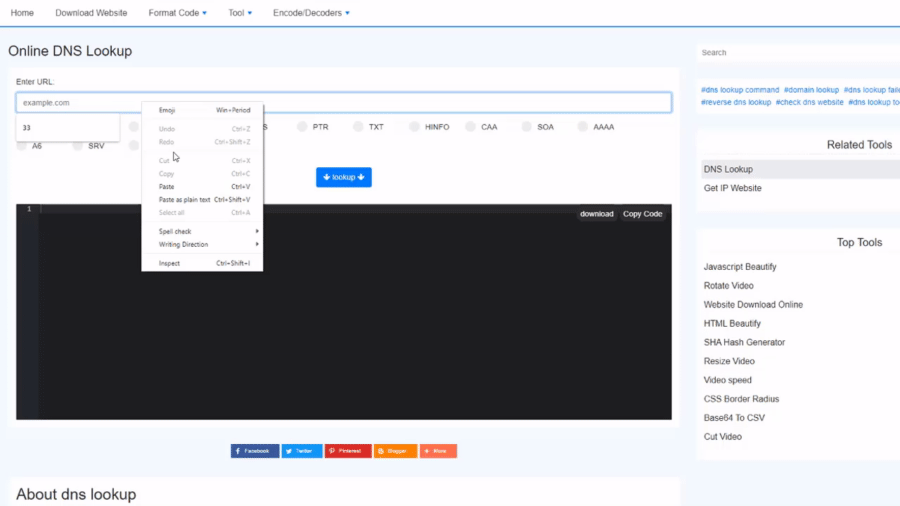About dns lookup
This test will list DNS records for a domain in priority order. The DNS lookup is done directly against the domain's authoritative name server, so changes to DNS Records should show up instantly. By default, the DNS lookup tool will return an IP address if you give it a name (e.g. example.com)
List of DNS record types
| Type | Defining RFC | Description | Function |
|---|---|---|---|
| A | RFC 1035 | Address record | Returns a 32-bit IPv4 address, most commonly used to map hostnames to an IP address of the host, but it is also used for DNSBLs, storing subnet masks in RFC 1101, etc. |
| AAAA | RFC 3596 | address record | Returns a 128-bit IPv6 address, most commonly used to map hostnames to an IP address of the host. |
| AFSDB | RFC 1183 | AFS database record | Location of database servers of an AFS cell. This record is commonly used by AFS clients to contact AFS cells outside their local domain. A subtype of this record is used by the obsolete DCE/DFS file system. |
| CAA | RFC 6844 | Certification Authority Authorization | DNS Certification Authority Authorization, constraining acceptable CAs for a host/domain. |
| CERT | RFC 4398 | Certificate record | Stores PKIX, SPKI, PGP, etc. |
| CNAME | RFC 1035 | Canonical name record | Alias of one name to another: the DNS lookup will continue by retrying the lookup with the new name. |
| DHCID | RFC 4701 | DHCP identifier | Used in conjunction with the FQDN option to DHCP. |
| DNAME | RFC 6672 | Alias for a name and all its subnames, unlike CNAME, which is an alias for only the exact name. Like a CNAME record, the DNS lookup will continue by retrying the lookup with the new name. | |
| DNSKEY | RFC 4034 | DNS Key record | The key record used in DNSSEC. Uses the same format as the KEY record. |
| DS | RFC 4034 | Delegation signer | The record used to identify the DNSSEC signing key of a delegated zone |
| IPSECKEY | RFC 4025 | IPsec Key | Key record that can be used with IPsec. |
| LOC | RFC 1876 | Location record | Specifies a geographical location associated with a domain name |
| MX | RFC 1035 RFC 7505 |
Mail exchange record | Maps a domain name to a list of message transfer agents for that domain. |
| NAPTR | RFC 3403 | Naming Authority Pointer | Allows regular-expression-based rewriting of domain names which can then be used as URIs, further domain names to lookups, etc. |
| NS | RFC 1035 | Name server record | Delegates a DNS zone to use the given authoritative name servers. |
| NSEC | RFC 4034 | Next Secure record | Part of DNSSEC—used to prove a name does not exist. Uses the same format as the (obsolete) NXT record. |
| NSEC3 | RFC 5155 | Next Secure record version 3 | An extension to DNSSEC that allows proof of nonexistence for a name without permitting zonewalking. |
| NSEC3PARAM | RFC 5155 | NSEC3 parameters | Parameter record for use with NSEC3. |
| PTR | RFC 1035 | Pointer record | Pointer to a canonical name. Unlike a CNAME, DNS processing stops and just the name is returned. The most common use is for implementing reverse DNS lookups, but other uses include such things as DNS-SD. |
| RP | RFC 1183 | Responsible Person | Information about the responsible person(s) for the domain. Usually an email address with the @ replaced by a. |
| RRSIG | RFC 4034 | DNSSEC signature | Signature for a DNSSEC-secured record set. Uses the same format as the SIG record. |
| SOA | RFC 1035 RFC 2308 |
Start of [a zone of] authority record | Specifies authoritative information about a DNS zone, including the primary name server, the email of the domain administrator, the domain serial number, and several timers relating to refreshing the zone. |
| SRV | RFC 2782 | Service locator | Generalized service location record, used for newer protocols instead of creating protocol-specific records such as MX. |
| SSHFP | RFC 4255 | SSH Public Key Fingerprint | Resource record for publishing SSH public host key fingerprints in the DNS System, in order to aid in verifying the authenticity of the host. RFC 6594 defines ECC SSH keys and SHA-256 hashes. See the IANA SSHFP RR parameters registry for details. |
| TLSA | RFC 6698 | TLSA certificate association | A record for DANE. RFC 6698 defines "The TLSA DNS resource record is used to associate a TLS server certificate or public key with the domain name where the record is found, thus forming a 'TLSA certificate association'". |
| TXT | RFC 1035 | Text record | Originally for arbitrary human-readable text in a DNS record. Since the early 1990s, however, this record more often carries machine-readable data, such as specified by RFC 1464, opportunistic encryption, Sender Policy Framework, DKIM, DMARC, DNS-SD, etc. |
| URI | RFC 7553 | Uniform Resource Identifier | Can be used for publishing mappings from hostnames to URIs. |


